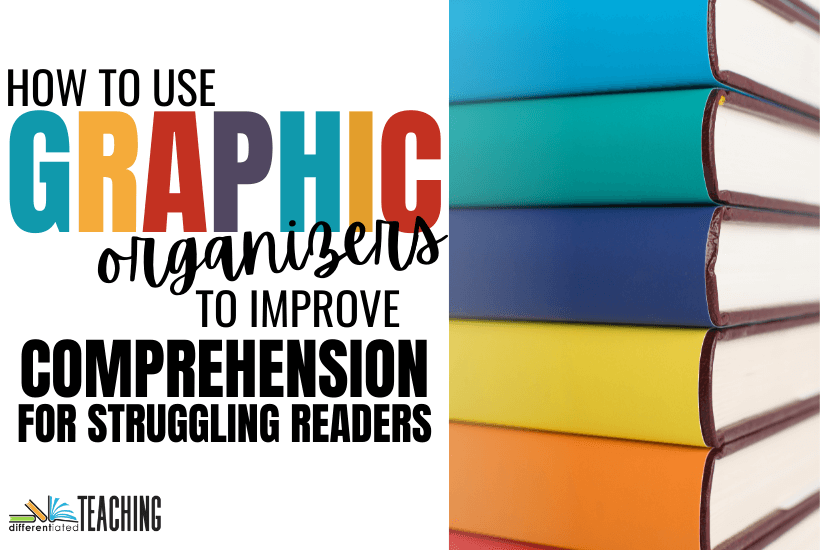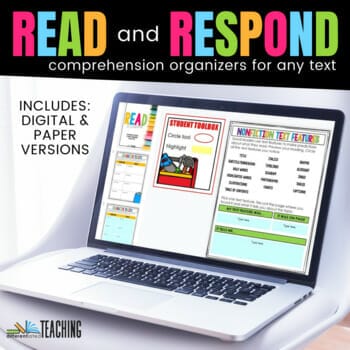Graphic Organizers for Reading: A Savvy Teacher’s Guide
While many struggling readers have difficulties decoding text, others struggle with understanding what they’ve read. Reading comprehension, or the ability to understand text, is a critical skill for all students. However, many students need explicit instruction and strategies to be able to apply the skills they learn in the classroom to their independent reading.

Graphic organizers help improve reading comprehension in the classroom. These tools are effective because they provide a visual representation of the text. They give students a clear process for breaking down and understanding what they’ve read. Ultimately, this can make it easier for students to follow the storyline or gather the key information from their reading.
In this article, I wanted to share some strategies and ideas for effectively using graphic organizers to boost reading comprehension for struggling learners. However, before we dive in, let’s ensure we’re on the same page with some background information.
What is a graphic organizer?
Graphic organizers are visual aids that help students organize, understand, and share information. They can be used with any text, from fiction to non-fiction, and adapted for students of all ages. Some types of graphic organizers can even be used as a formative assessment tool!
There are many different types of graphic organizers, but most share a few key features. First, graphic organizers typically have a title that focuses the student on the reading comprehension skill they’re working on. In addition, they include a series of bubbles, boxes, or other shapes that represent different pieces of information.
These shapes can be filled in with text, numbers, or images, depending on the type of graphic organizer and the student’s level.
Which graphic organizers can be used to teach reading comprehension?
Many different types of graphic organizers can be used for this purpose. Here are a few of the common ones you might already be familiar with:
- Venn diagrams for comparing and contrasting information
- Story webs for outlining the plot of a story
- Timelines for tracking chronological events
- Concept maps for illustrating relationships between ideas
What reading comprehension skills can you teach with graphic organizers?
When kids start reading, they must learn many new skills to help them break down and understand the text. Over time, those skills become more and more sophisticated. In addition, the text becomes more difficult.
Graphic organizers serve as an instructional tool to help students break down these sophisticated skills. This allows them to practice and develop a variety of reading comprehension strategies.

Some of the skills that graphic organizers can help teach include:
- tracking the plot of a story
- making connections
- sequencing & retelling information
- identifying main ideas and details
- understanding causes and effects
- predicting outcomes
- inferring or drawing conclusions
- identifying problems & their solutions
- comparing and contrasting
- analyzing story elements
- summarizing information
- fact and opinion
- character traits & development
- vocabulary & context clues
- theme & author’s purpose
- note-taking & gathering information
I created a bundle of print and digital graphic organizers for reading comprehension that can be used with any book. These are great for differentiation. Each student can use the same graphic organizer for a text at their own level. The pack contains 50 graphic organizers for reading comprehension skill-building and practice.
Teaching your students how to use graphic organizers for reading comprehension skill-building
Like all tools you expect students to use independently, students need explicit instruction on using graphic organizers correctly. Therefore, you’ll want to set aside time to introduce the organizer. You’ll need to break down its parts and give guided practice opportunities before students use these tools as part of their own reading.
However, this doesn’t need to be a drawn-out process. When done correctly, even struggling learners should be able to effectively use reading comprehension graphic organizers to improve their reading comprehension skills after just a few short lessons.
Here are the steps for introducing a reading comprehension graphic organizer as part of a reading comprehension lesson.
- Display and discuss the graphic organizer using a strategy like think-pair-share. Here, you want students to be able to notice the key parts of the tool more than how it’s used.
- Next, explain when they might use this graphic organizer for reading comprehension. Make sure you explain how it helps them break down their reading.
- Model how to complete the organizer using a familiar text. Be sure to incorporate a think-aloud process to verbalize your steps as you complete each section.
- Then, continue this step with a different text, but allow students to share what goes into the sections of the organizer. This will allow you to understand whether the students need more instruction.
- Provide practice opportunities in a variety of formats. You can include different pieces of text and whole group, small group, and partner work. Monitor and reteach those who seem to be having trouble using the graphic organizer effectively.
- Finally, have students utilize the graphic organizer independently. Monitor and reteach as needed. Offer guided practice – either with you or a partner – for those struggling.
How do reading comprehension graphic organizers help with reading comprehension?
If you’re on the fence about adding this extra step to your reading instruction, here’s more information on WHY you need to use this important tool when supporting students in building strong comprehension skills.
Understanding the intricate nature of written text is multifaceted. As students delve deeper into literature, they often encounter layers of meaning, complex character interactions, and intricate plot structures. Graphic organizers bridge these intricate details and students’ comprehension, offering a structured method to decode, interpret, and assimilate information.
Here’s how graphic organizers catalyze the reading comprehension process:
- Simplification of Complex Ideas: The visual structure of a graphic organizer distills complex information into digestible parts. Students can see the underlying structure by breaking down intricate narratives or dense information, making it easier to grasp.
- Engagement with Multiple Modalities: Struggling learners are best served through multisensory learning opportunities. Graphic organizers tap into the visual learning modality, providing a spatial understanding of concepts that might be abstract when only read.
- Active Interaction with Text: Graphic organizers encourage students to interact actively with the material instead of passively reading a text. They must identify key points, relationships, and sequences, engaging higher-order thinking skills.
- Facilitation of Retention: When information is organized visually, it becomes more memorable. Categorizing, linking, and mapping concepts on paper or digitally reinforces memory pathways, aiding long-term retention.
- Flexibility and Adaptability: One of the most significant advantages of using graphic organizers for reading comprehension tasks is their adaptability. They can be tailored to different texts, comprehension goals, and individual student needs. This ensures that learners at varying levels can benefit, from those just starting their reading journey to advanced readers tackling sophisticated texts.
Engage struggling learners with these graphic organizers for reading comprehension.
However, you must teach students how to use them. If you’re looking for ways to help your struggling readers improve their reading, grab my Graphic Organizers for Reading Comprehension to help support your students more effectively.









